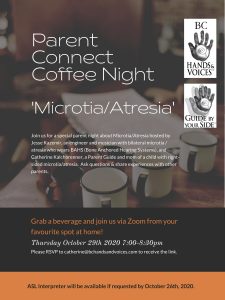By Gina Cooper
It happened in a safe place. With a deeply caring, experienced psychologist named Mary Beth Goring at the John Tracy Clinic Summer Session in Los Angeles.
Grief decided she had been pushed inside for too long and wanted a voice.
Grief imploded me and I experienced a slight psychotic break. No, I did not start shooting people or throwing things or shouting random obscenities. Rather, I began shaking and sobbing and pouring out my worries to a highly trained professional who had heeded her calling as a psychologist. This psychologist understood how nerve wracking preparing a child with hearing loss for the school system can be.
Raising a child with a special need, especially during the early years, can be so taxing on your nervous system that it makes me extremely grateful for organizations like Hands & Voices and the John Tracy Clinic.
I cannot imagine doing this job alone. The choices you need to make as a parent before your child can voice her own thoughts and desires can be overwhelming. The thought of making a mistake was unbearable for me at that time. I took the responsibility for a tender young life to heart, literally… anxiety and panic accumulated into a knot and simmered slowly underneath the joy, adventure and ongoing feelings of being a mother of a deaf child.

I never wanted Sara to see me in any way but happy. I desperately wanted her hearing journey to be adventurous and full of blissful memories to draw upon when older.
Grief is an integral part of our being and will rise to be heard when it needs to. Grief also has the compassion to wait until you’re in a safe place with a support network to catch you if you fall.
The John Tracy Clinic provided me with a group of experienced professionals and families walking a similar path. During a morning parent support group session, I gave a spontaneous speech about feeling alone, being blamed by a family member for my daughter’s deaf diagnosis, feeling overwhelmed by people’s opinions on cochlear implants and sign language, second guessing myself with regard to my choice of mainstream Kindergarten, feeling somewhat unwelcome at certain playgroups, not knowing who your real friends are, and child comparison. I spoke my truth and unburdened my heart of sadness, disappointment, anger and disillusionment. My brave front gave way to vulnerability and an individual yearning for society at large to comprehend what I did~that a child with a special need is still a child with potential, not a societal or personal burden, not a pity case, not a candidate for a lifetime of disability insurance or somehow not as intelligent. I cried not only for my daughter but for so many children and families who are sometimes marginalized by society. It is not right nor helpful to decide the fate of deaf/hard of hearing children without trying all means of therapy to enable them to achieve success in life.
My heart broke for every disadvantaged, impoverished child on earth. I knew not what to do with my feelings so I gave them voice in my parent support group and personal counselling sessions. To my grief I gave a platform during this 3 week intensive Summer Session of 2014 with accepting parents, unbiased professionals and a worry free environment.
Families come together globally to gain professional evaluation of their child’s readiness for the school system, to update their hearing loss knowledge, receive new training, and effectively prepare for the transition to Kindergarten.
What I received at the 2014 John Tracy Clinic Summer Session were qualified opinions from people who cared enough about you and your child to help steer you in a positive and effective direction. A direction which would set up your child for success.
Sara, my sweet and smart tomboy is now a senior at her elementary school – the big Grade 5 at Pinecrest Elementary School in Campbell River, British Columbia on Vancouver Island! She reads at an advanced level, enjoyed gymnastics, bike riding, swimming and art with hearing kids, and has a group of friends that accept her and her cochlear she without question.
Sara did attend monthly ASL classes with a group of other deaf and hard of hearing children in the community. I wanted to expose her to the hearing loss community and be receptive to her feedback about living with a “special need”. She decided this year that she did not want to draw attention to her cochlears or to talk about being a special needs kid. This was her choice and this choice may change down the road. I respect that. It’s what the Hands & Voices motto is all about…”What works for your child is what makes the choice right.”
I highly recommend the John Tracy Clinic Summer Session, if you choose to attend. I was given an evaluation that the therapy method of Total Communication was working for Sara. Sara was given an evaluation of above average speaking and listening skills, which shouldn’t have surprised me but did a little. The worry, hard work and massive effort had paid off but not without a price…a psychotic break is a signal for emotional attention, a signal for self care, a cry for validation, and a plea for people to understand that your reality is important. A psychotic break is by no means a sign of mental weakness. It is a signal of overwhelm just like any physical illness symptom and should be treated with dignity and compassion. In the name of love, we parents often climb mountains for our children…sometimes we ask for help repelling.
We returned to Campbell River feeling more confident, enlightened and educated and more prepared to enter the school system.
Yes, I was still feeling nervous. But in an excited kind of way.?














